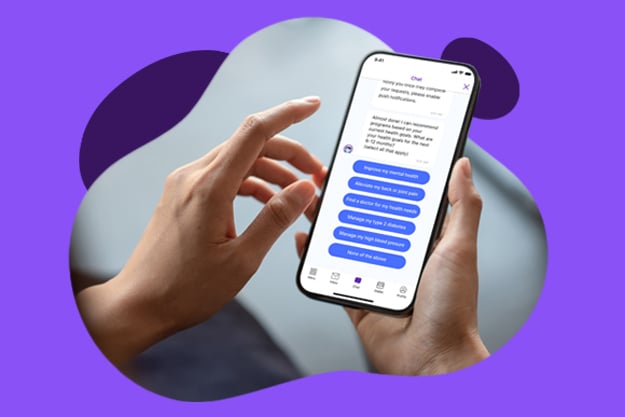How HealthJoy Gets in Front of Healthcare Decisions
For an employee, navigating the healthcare system is just a series of difficult decisions. With unclear pricing and confusing deductibles, it’s...
Connected Navigation Platform
Guiding to high-value care
Behavioral Health
Foster a mentally healthy workplace
EAP
Supporting holistic wellbeing
Virtual MSK Care
Reimagining musculoskeletal care
Virtual Primary Care
Powered by smart navigation
Surgery Centers of Excellence
Best-in-class surgical outcomes
Virtual Urgent Care
Immediate care, any hour of the day
Chronic Care
A new approach to chronic care
Integrations
Flexible to any strategy
4 min read
 Claire Wiseman Imber
:
December 4, 2019
Claire Wiseman Imber
:
December 4, 2019
Surprise charges and unexpected bills don’t exactly endear employees to their health benefits. Yet for many of them, getting care means opening those bills with a feeling of dread. Our healthcare system lacks price transparency, and it’s driving up costs.
The thing is, most employees know how to shop. They just don’t, or can’t, apply those skills to healthcare. That knowledge gap matters more than ever as employees shoulder more and more of the costs of healthcare. High deductible health plan (HDHP) enrollment increased from 15% in 2007 to 43% in 2018 and total yearly out-of-pocket expenses for a family are up to $13,800 for a family. Employees need to understand how to find the best care at a fair price, because the potential costs of not doing so can be devastating.
In gearing up for my second Chicago winter, I’ve spent a lot of time researching boots. I knew without even looking that full-grain leather kicks would cost more than the ones made of synthetic material. I also assume that pricier boots will fit better, last longer, and hold up to my frigid daily commute better than their less-costly counterparts.
Like most of your employees, I’m used to pricing variations. I’m able to look at a pricier product and know that, within reason, that price connotes a better product. I might not choose the most expensive option, but thanks to price transparency, I can use widely-available facts to make an informed decision.
What does this extremely seasonal problem have to do with employee benefits? Here it is: Medical procedure and care prices can vary as much as 10x from facility to facility. Unlike the boots in my online shopping cart, though, healthcare isn’t priced according to value. That makes shopping necessary, but challenging.
An MRI at your local hospital might cost $5,000, while an independent facility down the street might charge $500. Small changes—one provider performing your anesthesia instead of another, for instance—could result in wildly higher prices.
Perhaps the most confusing fact is that paying more for a medical procedure doesn’t mean you’ll experience a better outcome. An inexpensive medical procedure won’t necessarily carry more risk. More often than not, it’s the intricacies of a particular health plan or a provider’s network that causes wildly swinging costs and massive bills.
Worst of all, it’s hard for most of us to predict these variations without third-party tools and deep research skills. Yet that’s what our current system requires. To get care at a fair price, we have to shop.
So procedure prices vary wildly between locations, and we know those prices have no bearing on the quality of care we actually get. At the same time, more Americans than ever are on high-deductible health plans. Most of your employees won’t meet their yearly deductible, meaning a single procedure could cost them thousands of out-of-pocket dollars. To help employees navigate opaque healthcare pricing, encourage them to enthusiastically research the same way they would any other premium service (see How HealthJoy Gets in Front of Healthcare Decisions).
Let’s say your employee is having headaches and visits their general practitioner, who recommends a CT scan. Their GP is in their network, so they assume the scan is going to be inexpensive, too. But that’s not necessarily the case.
Their doctor may direct them to a CT scan in their offices or at their affiliated hospital. A procedure there may cost 10x as much as one just a few steps down the road. It all comes down to asking the right questions before scheduling that procedure, appointment, or screening. It may take a little digging, but some insurance providers and facilities can provide pricing estimates for standard procedures. Comparison tools and Google searches can make it simple to compare price estimates with feedback from real patients.
No matter how they get it done, upfront research is an essential step for employees because the total cost of that procedure impacts their out-of-pocket spending. Even more of the cost of that service is passed on to their employer.
When employees don’t shop for healthcare, they absorb some of the cost. But an even more significant percentage is passed on to employers. In some situations, though, personal savings might not be enough to drive employees toward less expensive choices.
Maybe your employee is dedicated to a specific doctor or facility. Perhaps they’ve met their deductible and aren’t concerned with cost. Maybe they even want to burn the rest of their FSA balance before the end of the year.
In those cases, an incentive can prompt cost-saving behaviors. Consider implementing an incentive program that provides a reward when employees use your preferred pharmacy provider or partner medical facility. Perhaps they’re entered into a drawing each time they make a smart choice, or accumulate points toward a gift card of their choosing. You can also research vendor options for a more structured incentive program with less maintenance.
HealthJoy clients who add HealthJoy Rewards choose from over 100 best-practice rewards to incentivize smarter healthcare choices. We deliver a 6:1 ROI. Learn more.
In most cases, it’s not enough to tell employees they should shop for healthcare. The process is just too complicated. Since following through often means researching on their own, using third-party apps, or even calling facilities, can you blame them for going with the first option they find?
Over the years, we’ve learned that price transparency encourages employees to become smart healthcare shoppers. We include pricing estimates whenever members request recommendations for imaging and procedures. That’s because these services are notoriously opaque, and prices vary widely. Our platform takes the place of insurance companies’ doctor directories, and is much easier for members to use. We aim to educate our members while taking on the burden of sorting through pricing and determining the best value.
We direct members to the highest quality, best priced, and most convenient facilities based on each specific situation. We’re able to do this because our platform integrates health plan information, medical needs, member preferences, and past interactions to guide our research (see HealthJoy Accelerates Your Cost-Containment Strategy).
We can tell them what the average cost of a procedure in their geographic area should look like, and find a fair-priced facility. We’ll help employees by actually finding the recommendations, presenting them with options, and even booking the appointment for them. Should they get a surprise bill or suspect an error, our expert bill review team can coordinate, clarify, and in many cases, find opportunities to save.
Choosing a healthcare provider shouldn’t require 10X the amount of obsessive research I put into selecting new boots. But a lack of price transparency and an unclear billing system makes it impossible to find high-value care without a little shopping. By encouraging and incentivizing employees to use their shopping skills in search of healthcare, you’ll help them save money and love their benefits.

For an employee, navigating the healthcare system is just a series of difficult decisions. With unclear pricing and confusing deductibles, it’s...

Employer healthcare costs climb every year. For individuals, the stakes are perhaps even higher.

Medical bills have the unsettling power to derail our lives. You probably know the feeling: as soon as you pull the envelope from the mailbox and...